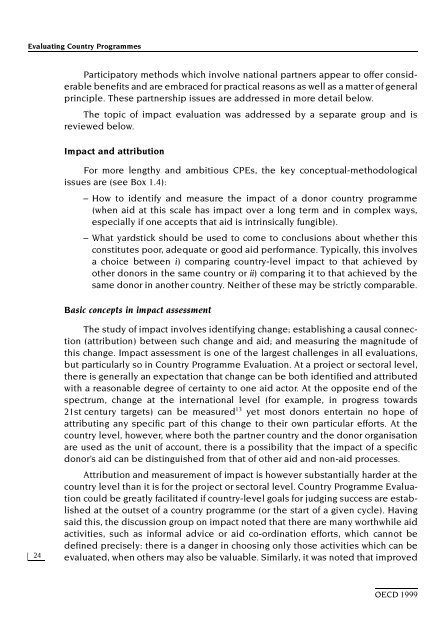Evaluating Country Programmes - OECD Online Bookshop
Evaluating Country Programmes - OECD Online Bookshop
Evaluating Country Programmes - OECD Online Bookshop
Create successful ePaper yourself
Turn your PDF publications into a flip-book with our unique Google optimized e-Paper software.
<strong>Evaluating</strong> <strong>Country</strong> <strong>Programmes</strong><br />
24<br />
Participatory methods which involve national partners appear to offer considerable<br />
benefits and are embraced for practical reasons as well as a matter of general<br />
principle. These partnership issues are addressed in more detail below.<br />
The topic of impact evaluation was addressed by a separate group and is<br />
reviewed below.<br />
Impact and attribution<br />
For more lengthy and ambitious CPEs, the key conceptual-methodological<br />
issues are (see Box 1.4):<br />
– How to identify and measure the impact of a donor country programme<br />
(when aid at this scale has impact over a long term and in complex ways,<br />
especially if one accepts that aid is intrinsically fungible).<br />
– What yardstick should be used to come to conclusions about whether this<br />
constitutes poor, adequate or good aid performance. Typically, this involves<br />
a choice between i) comparing country-level impact to that achieved by<br />
other donors in the same country or ii) comparing it to that achieved by the<br />
same donor in another country. Neither of these may be strictly comparable.<br />
Basic concepts in impact assessment<br />
The study of impact involves identifying change; establishing a causal connection<br />
(attribution) between such change and aid; and measuring the magnitude of<br />
this change. Impact assessment is one of the largest challenges in all evaluations,<br />
but particularly so in <strong>Country</strong> Programme Evaluation. At a project or sectoral level,<br />
there is generally an expectation that change can be both identified and attributed<br />
with a reasonable degree of certainty to one aid actor. At the opposite end of the<br />
spectrum, change at the international level (for example, in progress towards<br />
21st century targets) can be measured13 yet most donors entertain no hope of<br />
attributing any specific part of this change to their own particular efforts. At the<br />
country level, however, where both the partner country and the donor organisation<br />
are used as the unit of account, there is a possibility that the impact of a specific<br />
donor’s aid can be distinguished from that of other aid and non-aid processes.<br />
Attribution and measurement of impact is however substantially harder at the<br />
country level than it is for the project or sectoral level. <strong>Country</strong> Programme Evaluation<br />
could be greatly facilitated if country-level goals for judging success are established<br />
at the outset of a country programme (or the start of a given cycle). Having<br />
said this, the discussion group on impact noted that there are many worthwhile aid<br />
activities, such as informal advice or aid co-ordination efforts, which cannot be<br />
defined precisely: there is a danger in choosing only those activities which can be<br />
evaluated, when others may also be valuable. Similarly, it was noted that improved<br />
<strong>OECD</strong> 1999

















![CQE=U]^\]Z: KAZAKHSTAN - OECD Online Bookshop](https://img.yumpu.com/3915768/1/190x253/cqeuz-kazakhstan-oecd-online-bookshop.jpg?quality=85)